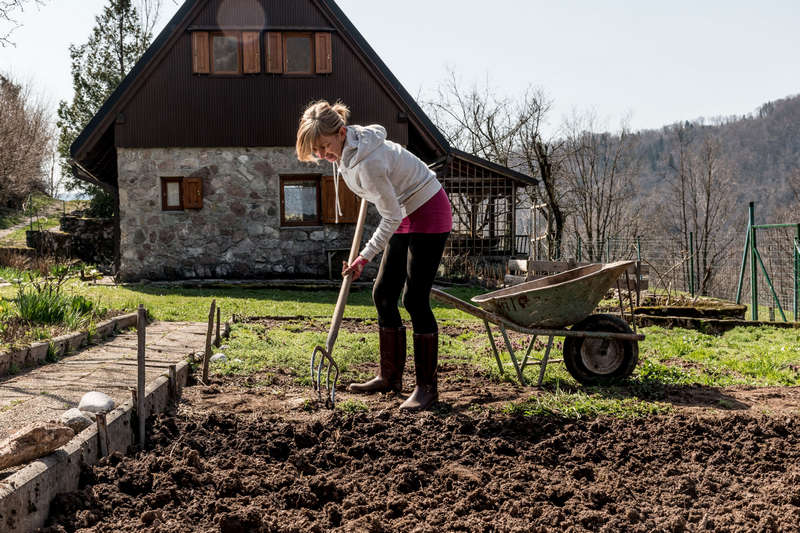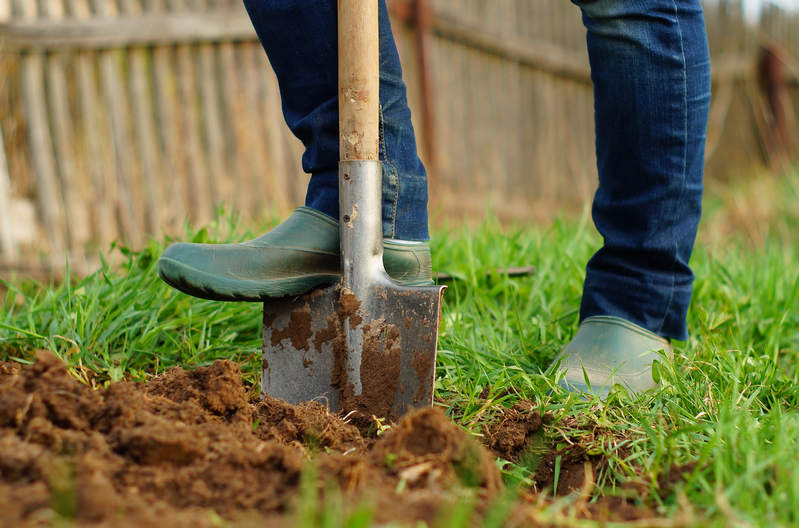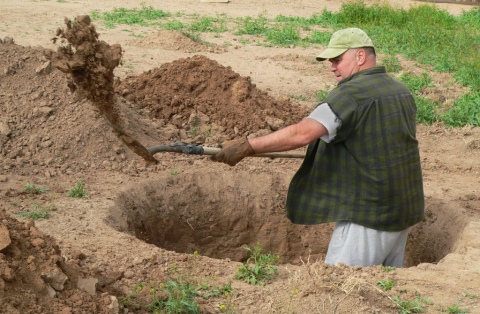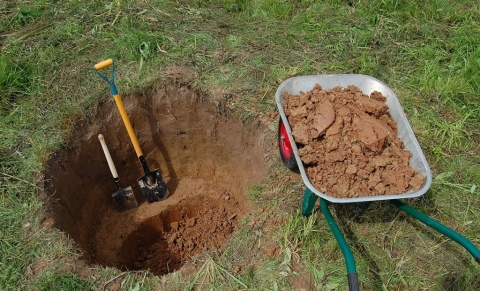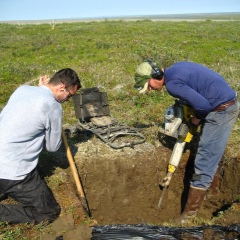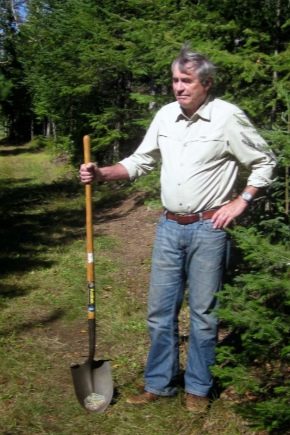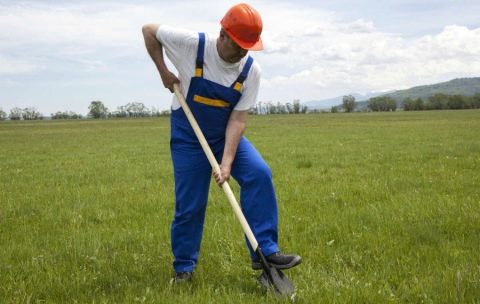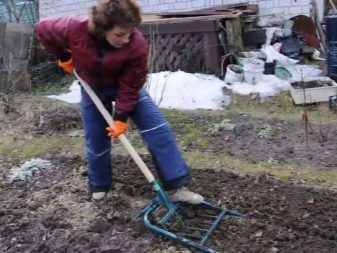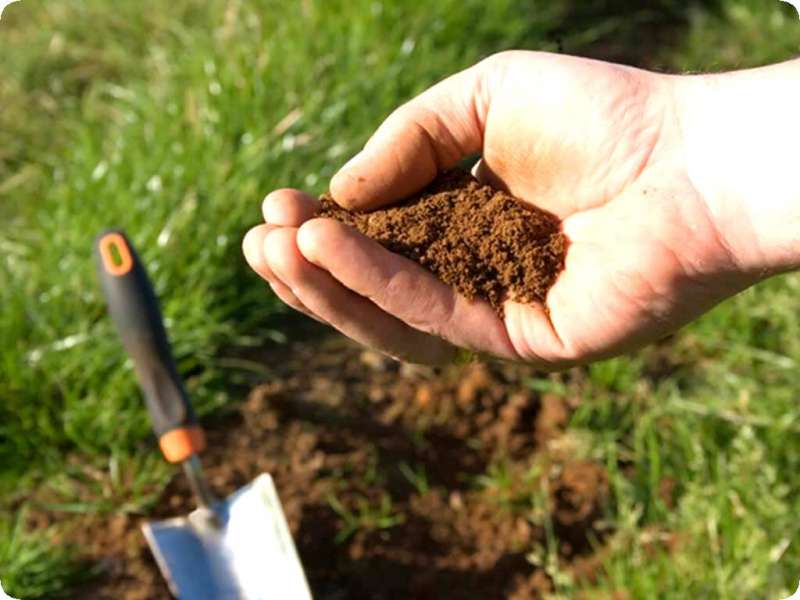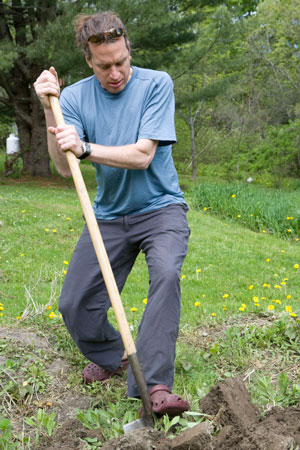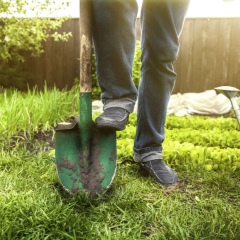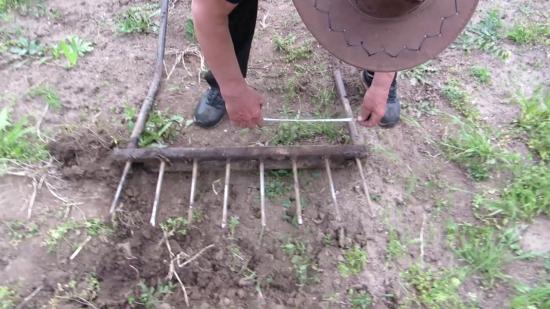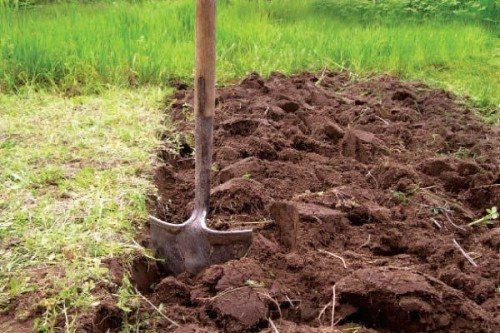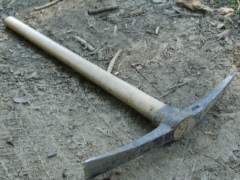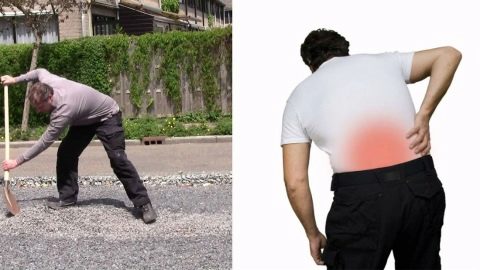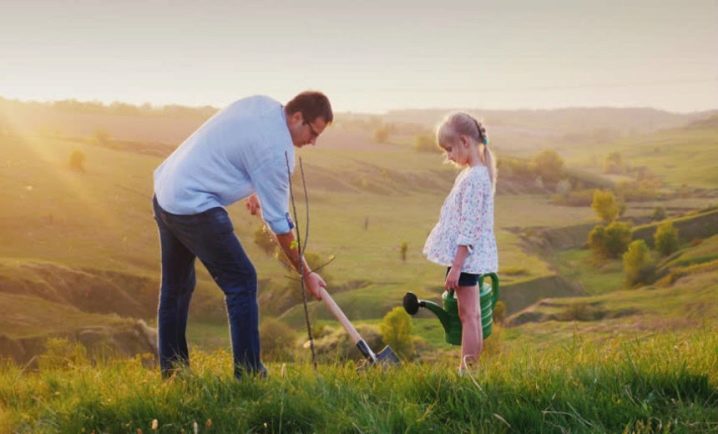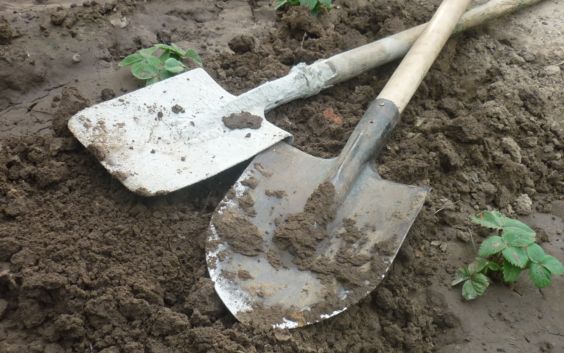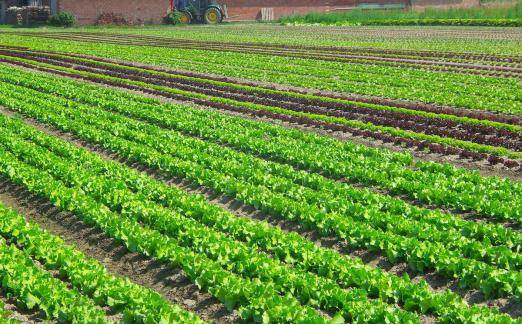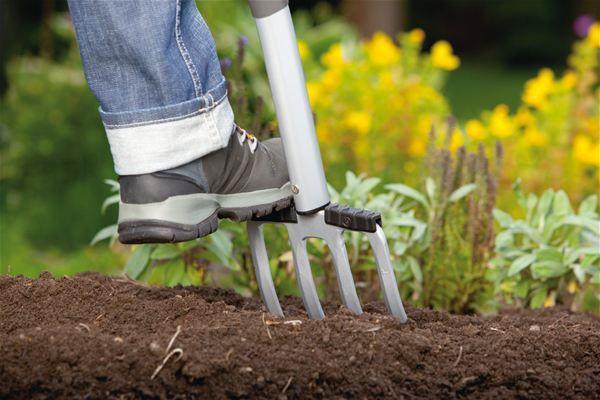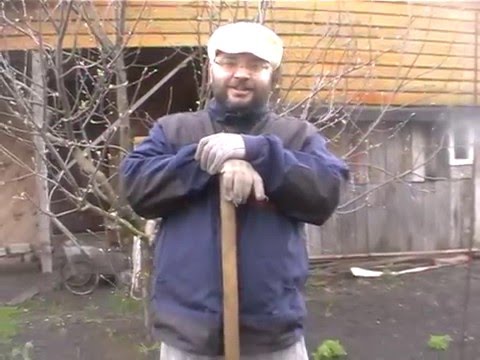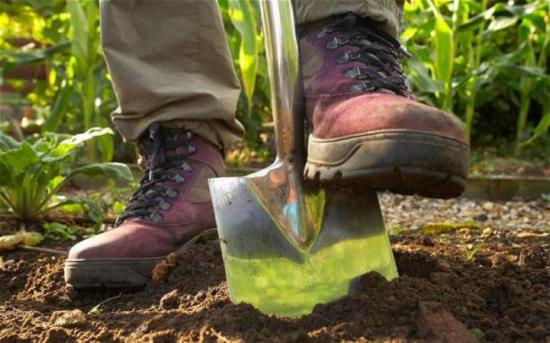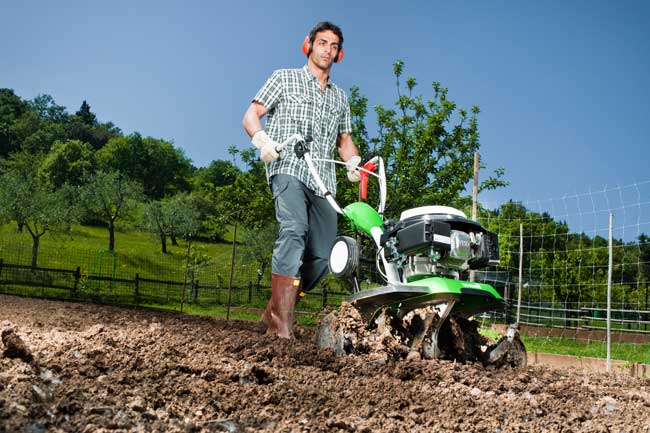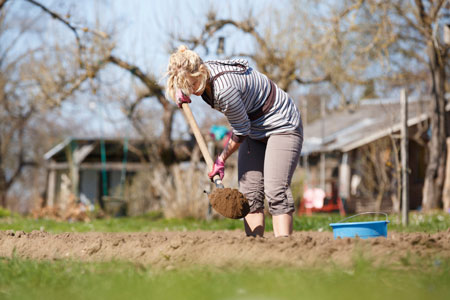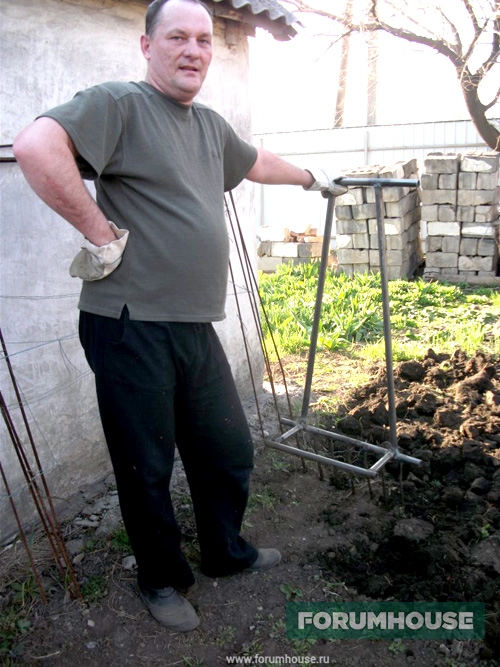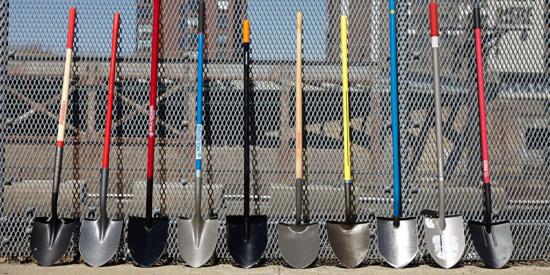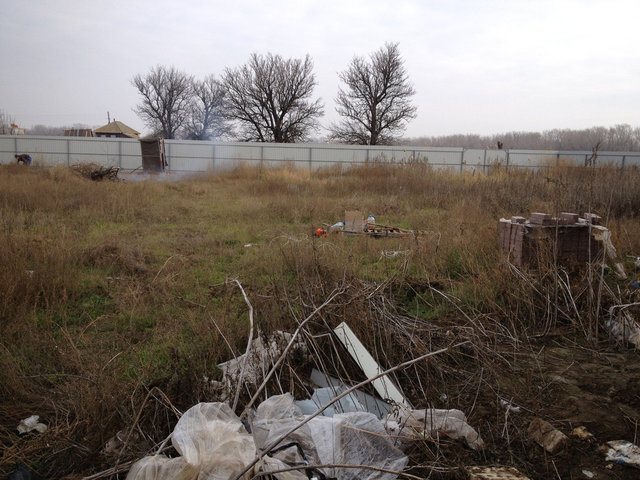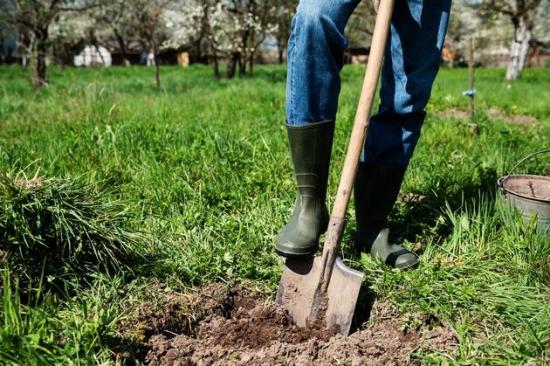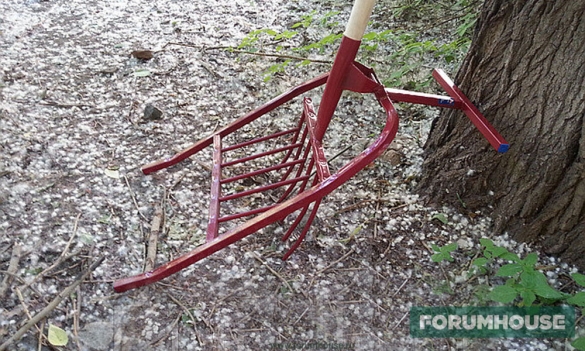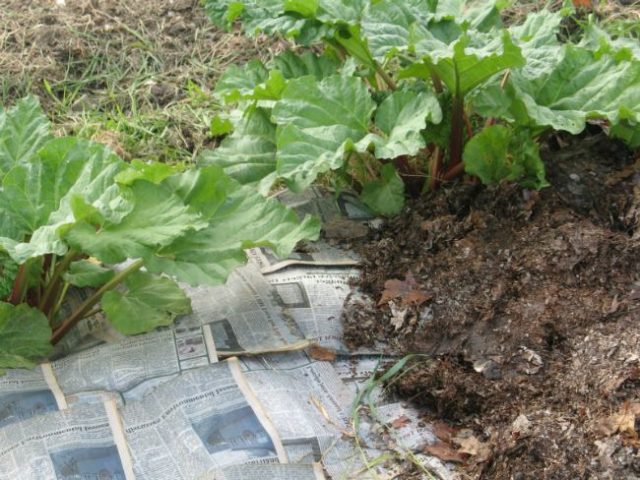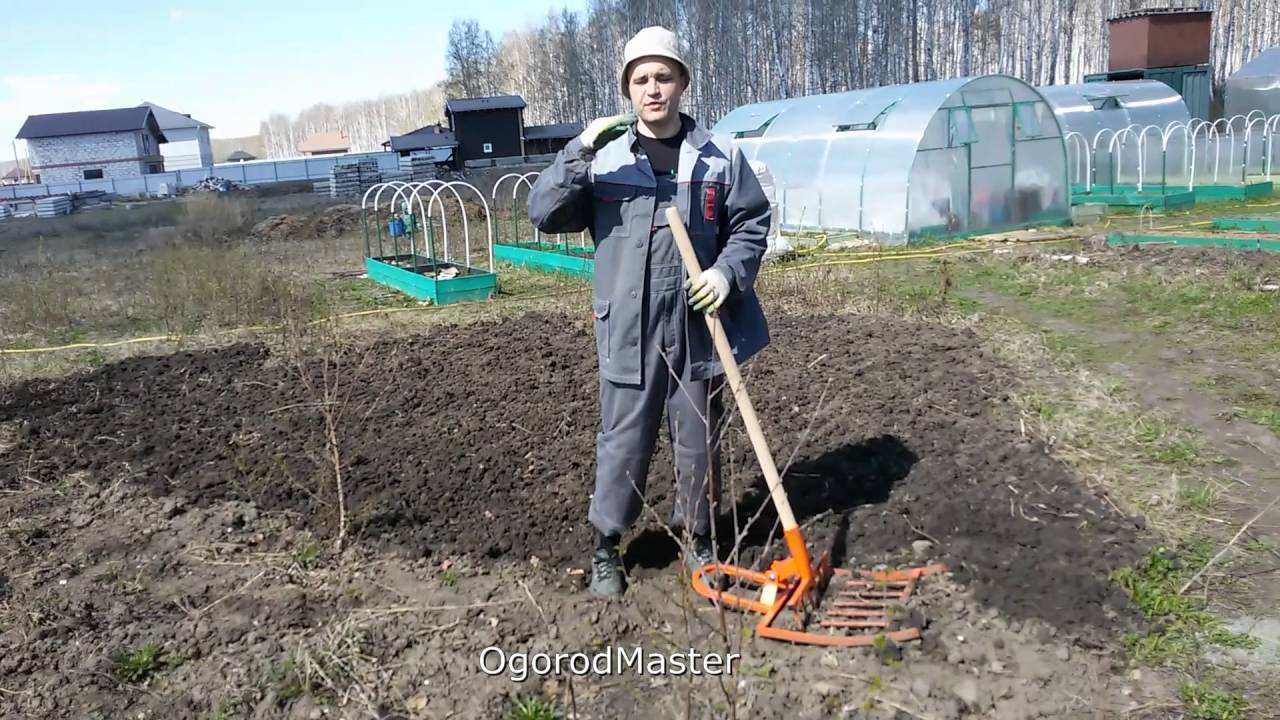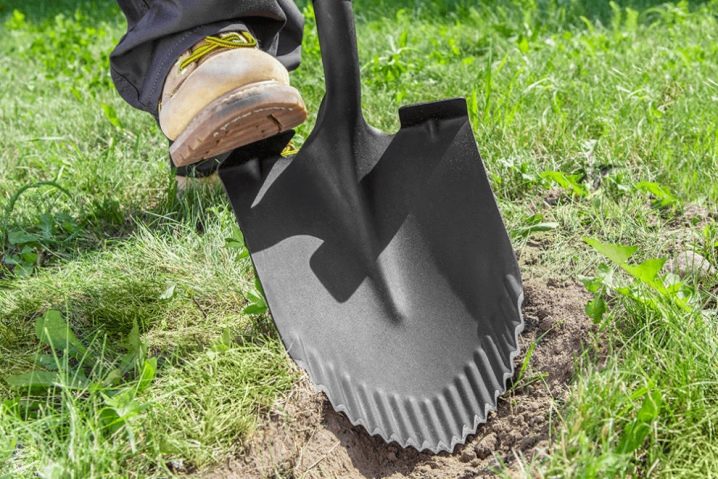Where does dense soil come from?
Surprisingly, by his attempts to improve the soil, a person himself spoils it. Experts are familiar with the phenomenon of a plow sole. It is a dense layer of soil that forms between the plowed land and the subsoil. Depending on the method of processing the site, the depth of this gap ranges from a couple of tens of centimeters to a meter.
 It is impossible to avoid the appearance of an arable sole.
It is impossible to avoid the appearance of an arable sole.
What is the harm of a plow sole? Impermeable to roots. Moisture and most nutrients accumulate below the sole, and the roots cannot get through to them.
Note that the thickness of this barrier also varies. On the beds it is only 10-15 centimeters, when processing the field with heavy equipment - up to 40 centimeters
It is impossible to avoid the appearance of an arable sole. Even working with one shovel is stressful for the soil. The weight of a person is quite enough to form a seal. In addition, people calmly walk around the site when there are still or no beds on it. Do you make circles, dragging sacks of potatoes across the field, or take a shortcut based on the rule that the shortest distance between two points is a straight line?
There are no plow soles in the forest. The soil is plowed by thousands of worms, and the probability that several living creatures will pass through the same area during the day is negligible.
What it looks like: harvesting parsnips and planting winter garlic
The situation is as follows: parsnips have dared in the garden; we plan to plant garlic in its place. Neighborhood rules are respected - this is an important point and should not be missed.
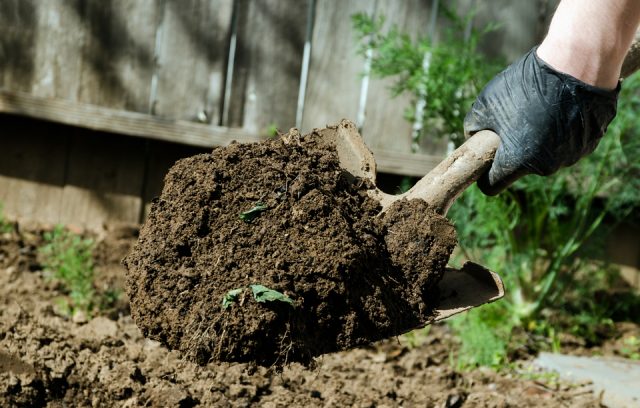 Autumn digging of ridges
Autumn digging of ridges
Parsnips have long roots. To get the crop out of the ground, you need the help of a shovel. We act carefully. We drive the shovel into the ground near the parsnip and make a slight movement - the sound of tearing roots should be heard. We take out the shovel vertically, without disturbing the soil layers, pull out the parsnips. We get the harvested crop and the conditionally dug up garden. Note that the soil is practically not injured in the process.
For the sake of interest, you can check the degree of softness of the soil after this method of growing and harvesting. Three years later, without digging, a thin twig easily enters the ground to a depth of 70 centimeters!
Now it's the turn of the garlic. With the help of a flat hoe, we slightly loosen and at the same time level the ground. Touch the top 3 - 5 centimeters, no more. Make holes for the garlic cloves with a peg, arrange them in places and sprinkle them. Work is done.
It remains to cover the beds with parsnip tops. Under natural conditions, it would remain lying on top of the ground - no need to break the rules. In spring, the soil under the leaves will be soft as fluff.
What is a sole and how to get rid of it
The sole is a layer of compacted earth that results from frequent digging of the garden to the same depth.
The formation of soles is susceptible to heavy soils (sod-podzolic, clayey) and waterlogged. It is recommended to carry out a two-tiered digging of the territory every 4-6 years.

Important! Two-tier digging should not be abused. Useful substances are eroded
The sole inhibits the growth of many root plants: celery, carrots, beets, onions, parsley, etc., and deforms their roots.
If the sole is strongly compacted, then stagnation of water occurs, contributing to the development of unfavorable bacteria and microorganisms, which subsequently affect the development of vegetables.
Two-tier digging of the garden will help to get rid of the sole.It is advisable to carry it out in the fall, so that useful microflora can form during the winter and spring periods. To do this, you need to dig a furrow to the width of your shovel's bayonet and loosen its bottom with a garden pitchfork. In this case, the soil along the edges of the furrow must also be loosened. After that, you can add compost or manure. As a result of such digging, the arable layer increases, and the earth is saturated with oxygen necessary for the development of useful substances, its physical and water properties improve.
Did you know? With a two-tiered digging, the top layer of low-fertile soil is not taken out.
Again quotes
A little about the recommendations from country magazines. One of the readers says that she digs the beds twice for carrots (in autumn and spring), applies humus and mineral fertilizers. The gorgeous crop from the photo above was grown contrary to all these rules. And not the first time, not by chance, but from year to year.
It is known that carrots came to us from the Mediterranean. It was originally grown on cultivated former peatlands, so heavy soils are not suitable for it. In the beds, formed practically without outside participation, the root crop feels great. Need proof? - Go back to the photos.
More about the rules of cultivation in the next video.
How to properly dig the earth with a shovel. How to dig in the garden: advice from experienced
 Seeing how inexperienced summer residents hold a shovel in their hands, we decided to tell everyone how to dig in the garden correctly, so much so as to benefit the soil and not harm ourselves.
Seeing how inexperienced summer residents hold a shovel in their hands, we decided to tell everyone how to dig in the garden correctly, so much so as to benefit the soil and not harm ourselves.
We are absolutely serious, and in front of you now is not a joke, but quite serious material, and even instructions for using a shovel in the country, so to speak. We were literally prompted to write it by the current warm season, when young people were seen in many suburban areas. Naturally, this is very good, because young people cultivate the land, which means they are busy with useful work. But this is precisely where the positive from what he saw ends, since the shovel is in his hands, this is not yet a reason for applause. First, you need to learn how to dig correctly, and only then you can take up the tool.
How to dig soil in the garden and vegetable garden: instructions
Now we will provide you with literally a few points that will tell you in detail how to dig in a vegetable garden or garden.
The most important thing in such a process is the right choice of tool.
- One hand rests on the edge of the shovel handle, the other - a little further, clamping the handle in the palm, the leg is placed on the top of the shovel tray and pressure down into the ground occurs, preferably at a slight angle.
- After the shovel blade has sunk into the soil, you need to take a more comfortable position for lifting and dumping the earth, which means you need to take a step back, bend a little and put pressure on the shovel shaft, intercepting with one hand even closer to the tray.
- Now, you can bend your knees a little and press down as much as possible on the handle, which, with the effect of a lever, will pull the earth out of the hole.
- Lift the shovel with soil, turn it over and lower it into the hole, hit the largest lumps of earth with the blade of the shovel several times to break them.
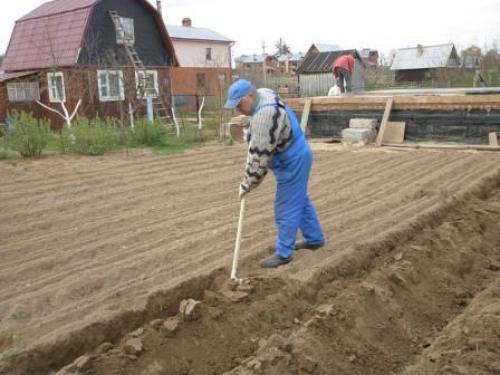
You see, digging with a shovel is very simple, it is strange that many do not succeed the first time.
We remind you once again that the material on how to dig the soil correctly is only for newcomers to the dacha, garden and vegetable garden, and does not in any way apply to experienced summer residents, who themselves are able to give such advice.
How to dig a vegetable garden without leg injuries
It often happens that at the moment of excitement or anger, we forget about safety measures, and we want to break a large earthen clod, break the root or stem of a large weed with a shovel blade, and so on. But, it often happens that such an action can injure the performer of this work.To prevent this from happening, try to be serious about the process, not get nervous during work, keep a safe distance between the shovel and your feet during such an action, and also try to dig in closed shoes, for example, in boots. Of course, it is not particularly pleasant to do this in the summer, but believe me, an injury with a shovel or even dry skin of your feet with dust (if you work in slippers) are much more unpleasant.
How to dig a vegetable garden without calluses
So that while digging the soil you do not get unpleasant marks on your hands, you must use gloves, high-quality, ragged with rubberized splashes (these are very convenient in such work). Also, try to hold the shovel correctly, do not put too much pressure on the handle with your palm when you can use the force of the leg for this, and also do not hold the shovel very tightly with your hands when turning the ground into the hole.
That's all, just a couple of practical tips, and we again return to more serious topics, but we are proud that now many will be able to learn how to dig correctly in the garden and vegetable garden, without injuries and unnecessary overwork.
How to prepare the soil for planting vegetables
After the first processing of virgin land, you can not immediately start cultivation. It is necessary to additionally prepare the ground. If the soil has been cultivated with machinery, then weeds are not taken from it, as in manual digging, but are plowed together with the soil.
After plowing with a walk-behind tractor or tractor
To improve the structure of the soil, and to saturate it with useful microelements, green manure plants (mustard, lupine, oats, rye, alfalfa) are planted. When the greens grow, they are mowed and additional digging is carried out using technology or by hand.
For the winter period, winter crops are planted. In early spring, after the snow melts, the third plowing is carried out and the site is planted with garden crops for the first time.
After manual digging
When cultivating the land manually, you can use the previous method, but more often they do it differently. The land freed from the sod is treated with herbicides from weeds. Then sprinkle with peat, humus or sawdust and dig up, stirring everything.
A week later, the soil is fertilized with complex mineral fertilizers: potassium sulfate, ammonium nitrate, nitrophosphate, superphosphate and dug up again. The land becomes suitable for use as a vegetable garden.
Organic farming and soil cultivation features

Organic farming is based on respect for the land
Proper, intelligent land management will help maintain and improve soil fertility. That is why organic farming advocates adhere to the following principles:
- The loose layer should be no more than 5 cm. Digging and plowing are prohibited. If you dig the soil for 2-3 years, then it is enriched with oxygen. The activity of microorganisms is manifested, the root system of plants more easily extracts nutrients. But then a decline sets in, and the soil becomes poorer: the amount of humus decreases and its structure changes.
- Mulching. Beneficial microorganisms and worms are activated under a layer of mulch, moisture is retained, soil crust does not form and the earth does not overheat on hot days
- Revitalization of the earth due to feeding the living fauna with compost, green manure, organic compounds that penetrate into the deep layers during irrigation, nourishing the roots of plants. Trenches are dug along the beds for irrigation.
- In the course of gardening work, the introduction of drugs with microorganisms in the composition. This technology was developed by Japanese scientists and has been successfully used for 15 years. The beneficial microbes and fungi introduced into the soil begin to actively divide, suppressing the pathogenic microflora and bringing organic matter into a form accessible to plants. Effective microorganisms significantly increase yields. It's easier than waiting for them to multiply gradually.
- Crop rotation is important so that part of the land is "fallow", and in other areas there is a change of crops. This is necessary in order to avoid the accumulation of pests and diseases in the soil that parasitize a certain plant family.

Organic farming
Organic farming involves little loosening of the soil. This is necessary to enrich it with oxygen, trim weeds and prepare it for planting. The rest of the work is completed by worms and microorganisms: they loosen and process nutrients, converting them into a form accessible to plants.
Flat-cut cultivation as a soil care option

Loosening the soil with a flat cutter
In organic farming, a shovel is not needed; a flat cutter is used, which goes underground and loosens it without digging. This tool is needed not only in the spring. It is perfect for killing weeds throughout the season.
A sharp flat cutter is used:
- with surface tillage to a depth of 5 cm
- when creating ridges
- to destroy excess growth and raspberry cuttings
- while hilling potatoes
- for removing strawberry whiskers
- when cutting seed furrows
- for thinning densely emerged seedlings
The miracle plane cutter will help loosen the ground under the cucumbers, which have a shallow root system. But it is impossible to dig up an overgrown area that has not been cultivated for a long time and sod has already formed.
A blunt plane cutter is recommended for land plots overgrown with weeds. Weeds caught under the blade of the tool are not only trimmed, but also turned out by the root. At the same time, the soil ecosystem remains intact and does not suffer from external interference. Flat-cut harvesting of weeds is carried out throughout the summer. It will not hurt at the dacha in the fall.

How to improve soil fertility? TOP-8 environmentally friendly options + agrotechnical methods | + Reviews
Reason one: digging deprives the soil of living organisms
We are used to thinking of the earth as inorganic matter, that is, inanimate, and we treat it accordingly. And the soil is a very complex living organism with its own hierarchical structure, its own laws of community, densely populated with microorganisms and lower animal organisms, such as, for example, earthworms.
When digging to the depth of a shovel bayonet, turning the layer over, we change the soil layers, and each type of microorganism finds itself in an unfavorable environment for itself. Most of them die at the same time, and the soil, devoid of microorganisms, loses its fertility. And at the same time, it is completely useless to apply any fertilizers until the restoration of its population occurs.
Losing its inhabitants, the soil, along with them, loses its structure. This soil is washed away by the rains and carried away by the winds. You probably have your own experience on this issue. Remember: you are pouring a large pile of soil, for example, removed from the place where you are going to build a house, and then you want to use it for the beds. And suddenly you discover that for some reason the soil has become barren, although you have piled mostly sod into this heap.
Thanks to the use of agricultural machinery, today we have almost completely ruined fertile lands on the entire planet and an inexorable decline in soil fertility. You and I cannot enlighten all mankind, but we ourselves are quite capable of halting destructive agriculture and restoring the lost natural fertility of the soil on our own sites.
How are these microchannels formed in the soil? The fact is that the root system of plants is huge. It not only can go down to 2–5 m (in beets, for example, the central root can penetrate up to 3–4 m, and in cucumber - up to 1 m), but it also branches in all directions, and each of these roots is covered hundreds of thousands of sucking hairs, the total length of which can reach 5-10 km! As a result, every inch of the earth is literally riddled with these hairs.
When the aerial part of the plant dies off, soil microorganisms begin to eat the remnants of the roots. As a result, microscopic channels are formed, through which moisture penetrates, and after it is absorbed by the soil, air rushes into the soil through the channels.In addition, worms make passages in the soil, which also serve as channels for water and air, only larger ones. Through all these passages, the roots of the next generation of plants can easily penetrate into the depths of the soil.
We are strongly advised to do the autumn digging of the soil in order to destroy the pests that have settled down to winter in the surface layer of the soil, as well as so that moisture penetrates between the clods, freezes and expands the passages for spring water and air, which will rush into the soil layer through these cracks.
Useful waste paper
This very original method will be effective if you follow the instructions carefully. To translate it into reality, you will need rotted manure (you can use chicken droppings, compost or humus). This composition must be evenly distributed over the entire area of the cultivated area and covered with black and white newspaper 5-7 layers thick on top. If you find it difficult, the newspaper can be replaced with thick cardboard. Compost mixed with manure is poured on top of the paper layer.
The advantage of this method is that in newspapers you can make holes in which you can plant any crops grown through seedlings. This is perfect for those who do not want to wait long, content with only potatoes and cabbage. At the end of the season, in addition to an excellent harvest of crops grown, you will also receive a clean plot, with soil enriched with vitamins and microelements.
Correct "marking" of the site
An important role in the formation of an "uncultivated" vegetable garden is played by the number of beds and paths between them. To begin with, along the perimeter of the garden, you should trample a flat path so that you can drive up with a wheelbarrow to any point on it. Then you should outline the direction of the beds and start "conquering" the garden space with the help of a plane cutter.
Having formed several beds, their surface should be leveled with small rakes, leaving low sides. It may seem that the soil in the new beds dries up instantly, but this is true only for the superficial 3-5 cm layer. At a greater depth, moisture remains, which allows you to grow carrots, onions and many other crops.
On a site divided into zones, it is easier to form your own microclimate
In the first year after harvesting, you need to sow siderates (mustard, phacelia or fenugreek) so that a nutritious "blanket" for the winter is formed on the soil. Already in the next spring, the soil "breathes deeply" and becomes soft and pliable.
Perhaps, such methods will seem unacceptable to someone: they are not suitable for all climatic zones. But one thing is obvious - the deep plowing of lands over time leads to their impoverishment and degeneration. So you need to manage wisely!
How to properly dig virgin soil
Virgin land is land that has not been cultivated in any way, has not been plowed by anyone and, on the one hand, is wild.
If you have such a site, then this is a great reason to process it and get moral and physical satisfaction from the results.
Once you have gathered the strength, tools and inspiration, you can start right there. But keep in mind that this is a terrible work and test.
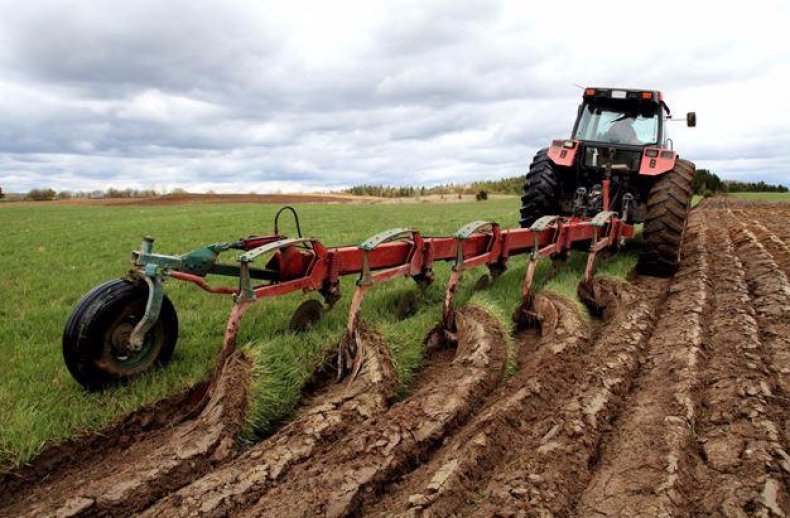
Important! When choosing a site, you should make sure of the amenities that are nearby: water, a store, a gas station, roads.
You can process virgin soil both with the help of technology, and on your own (it depends on your health). The method of processing with equipment is quite simple, but before you think that, except for a tractor, there is nothing to dig up virgin soil, remember about your hands and feet. An excellent tool, and most importantly, free, for the conquest of virgin lands.
Manual processing is a complex and time-consuming process. First of all, you need to choose the right season. The autumn digging period is perfect for such work. Since you need to clear weeds from your abandoned area to cultivate virgin lands, start by choosing a petrol cutter.You can take the usual one, but then the duration of the work will increase.
Important! It is also necessary to mow grass and weeds on virgin soil before mechanical processing. You will also need a shovel.
It is best to dig up virgin soil in parts, dividing it with a thread. You need to dig to a depth of at least 15 cm. We leave the dug area to dry out for a while. Then you need to walk along it with a pitchfork and fluff the ground
You will also need a shovel. It is best to dig up virgin soil in parts, dividing it with a thread. You need to dig to a depth of at least 15 cm.
We leave the dug area to dry for a while. Then you need to walk along it with a pitchfork and fluff the ground.
When digging virgin lands, it is important to be patient, because such a thing, due to its complexity, is often abandoned.
What is good about autumn digging
Digging of the garden is especially necessary in the fall for heavy, uncultivated clay soils. At the same time, work is performed on other types of soil. Autumn digging of the garden has the following advantages:
- With deep cultivation of the land in the garden, all pests rise upward. Colorado potato beetle, wireworm, rodents, cabbage, caterpillars - all of them will be eaten by birds or die from cold, wind, sun.
- At the time of the autumn digging, weeds sprout under the still warm daytime sun. The hardened crops then die in the first frost. The non-germinated weed dies from the wind, cold even at the seed stage.
- During autumn digging, the remains of cultivated plants go into the ground. They simultaneously fertilize the soil, work as a baking powder.
- In well-loosened soil, nitrogen-fixing microorganisms begin their active activity. They enrich the earth with all the forms of nitrogen it needs.
 How to dig with a shovel correctly
How to dig with a shovel correctly
- When digging a garden in autumn, you form a better retention of moisture in it (precipitation in the form of rain and snow). In the spring, such land, warmed by the sun, will be more convenient for plants. It will create a kind of greenhouse effect for them.
- The ability to apply the necessary fertilizers to the soil, which will completely rot and rot during the winter. Most often it is wood ash, green manure, sawdust moistened with urea.
Interesting: The use of wood ash in the garden
Important: when digging a garden in autumn, it is important to remove all fallen leaves from it. It is a mistake to think that it will be a good fertilizer.
Often, the foliage can contain diseases and pests, which will begin their harmful activity in the soil.
In extreme cases, you can then cover the dug-up garden with fallen leaves. In the spring, it will need to be removed from the beds.
And the most important plus of the autumn digging of the garden is that by performing such work on the eve of winter, we make it easier for ourselves to carry out spring soil cultivation before planting. In warmer months, it will be enough to just slightly loosen the ground and form the beds.

Do I need to dig a garden?
It is imperative to dig a garden if the soil on it is heavy, clayey or loamy. The fact is that such soils retain moisture for a long time and have low air permeability. When you dig up heavy soils or those with high groundwater levels, you form a microporous soil structure. All pores are filled with air. That is, the land acquires in volume almost twice. In such loose soils, plants rot more easily if left over for the winter.
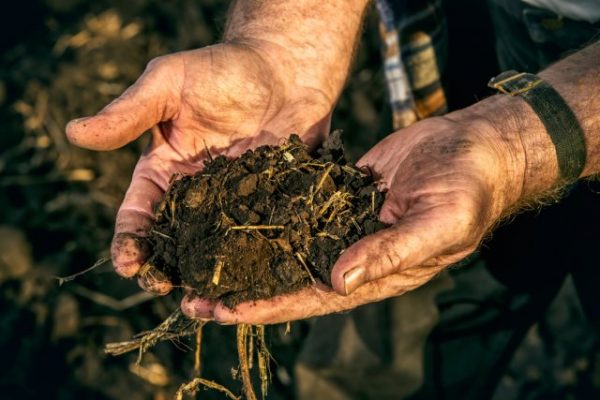
Light, initially loose soils do not need digging in autumn. If you turn them over again, then you violate the structure of the soil.
Digging a dense clay garden in the fall is essential. They do this in order to avoid such consequences:
- Soil salinization. This is a major land problem, especially in regions where the climate is very humid. In this case, only the top layer of the soil always dries out. At deeper levels, salt always builds up. As a result, such an indicator greatly reduces the yield on the site.
- Accumulation of weeds and pests.If the ground is not touched, they behave in an extremely impudent manner. They take root and settle in the deep layers of the earth. Then the yield is greatly reduced.
- Strong soil compaction.
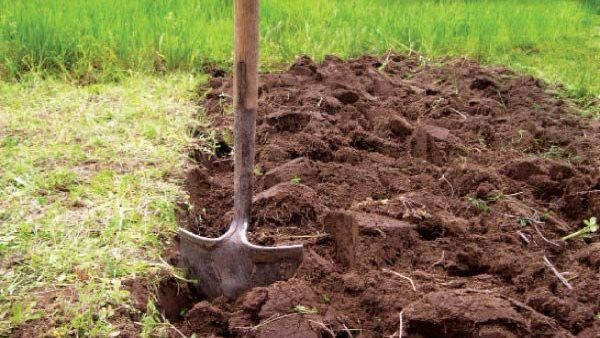
Advice: the answer to the question "Do I need to dig a garden in the fall" sounds like a firm "Yes". Moreover, it is better to dig it in the fall, and not in the spring. The autumn digging must be done deeply.
Work is carried out immediately after harvesting, before the onset of severe cold weather and snowfall.
Interesting: What can be planted after which in the garden
Correct technique
It is necessary to dig correctly at least in order to make the whole process much easier and faster.
As a child, many saw how to use a shovel.
The basic movements remain the same, but you need to pay attention to one main point - you cannot lift the instrument with the ground using your wrists. You need to try to hook the end of the handle with your elbow, thereby giving an additional impulse, due to which the load on the back and joints of a person will be reduced
Following this simple rule, you can dig up a large vegetable garden without any problems.

The position of the leading hand can be alternately changed while maintaining the necessary balance.
This technique becomes especially useful and necessary for large-scale and long-term work, for example, when it is required to dig a garden or remove large amounts of snow in the winter season.

When is it better to dig a garden - timing
Experienced gardeners note that digging land in the garden in the fall is much more useful than in the spring. With this procedure, you can quickly get rid of many problems. This is especially true for regions with arid soil.
This technique is called "winter plowing". After it, the inverted weeds freeze and die. If you dig up a garden in the spring, then the weeds can germinate again. Therefore, it is recommended to dig the earth in the fall every year. This will maximize the result.
In the fall, you can not only dig up a garden, but also add compost, humus or manure to the soil. In vegetable gardens, where crops often suffer from Colorado beetles, beetles, wireworms and other parasites, digging allows you to eliminate their larvae. To do this, the ground must be turned over to a depth of 20-25 cm.
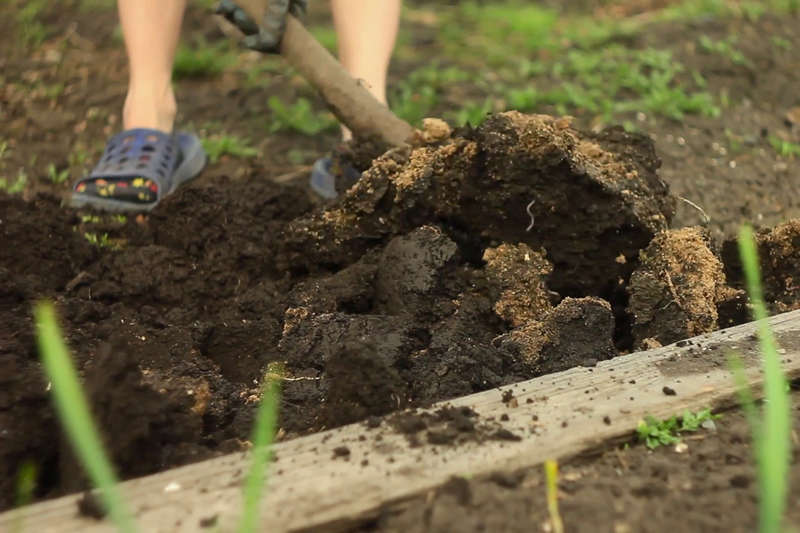
In this case, it is necessary to take into account the timing of processing the site in the fall. This may vary from region to region. It all depends on the weather conditions. The general approach is this: you need to dig up the ground as late as possible in the fall, before the first heavy rains and the onset of frost.
After harvesting, you need to grind the tops, distribute it in an even layer on the surface of the soil and dig up the earth manually or using a special tool (light digger) or equipment (walk-behind tractor). It is recommended to schedule the procedure in October-November as long as the temperature outside is maintained above 0 ° C.
Digging the soil in the garden in the spring will have a beneficial effect on the yield of vegetables, as it becomes loose and saturated with oxygen. The time for digging the land in the spring also depends on the weather conditions of a particular region. You need to dig up the ground in the spring no later than a week before planting vegetables in the garden. Unlike autumn, in the spring you can do a shallow digging of soil in the garden (up to 10 cm).
Tools for digging a vegetable garden
You can dig up a garden using various tools.
Bayonet shovel
This is the most common tool for digging a garden, but if the area is large enough, the process can take several days. It is very long and laborious to dig with a bayonet shovel, but it is still the most popular method.
Pitchfork
It is good to use a pitchfork to dig an area where the soil is light and loose. Loamy soils for digging in with such a tool will not work.
Miracle shovel
This tool allows you to quickly and conveniently dig up soil in the area.The tillage process becomes less time consuming and more efficient and high quality. The miracle shovel combines the work of two tools - a shovel and a pitchfork.
If the digging is done with a shovel, then you do not need to collect a lot of soil on the bayonet. To prevent the dug-up part of the garden from becoming compacted, you do not need to walk on it, so the direction of the digging should be backward. Before digging up the garden, you can scatter peat, compost, fertilizers or humus over the area. And then dig up the ground.
Recommendations
The process of leveling a suburban area is considered difficult, taking a lot of physical strength and time. Therefore, many land owners prefer to use the services of professionals who do everything quickly and correctly.
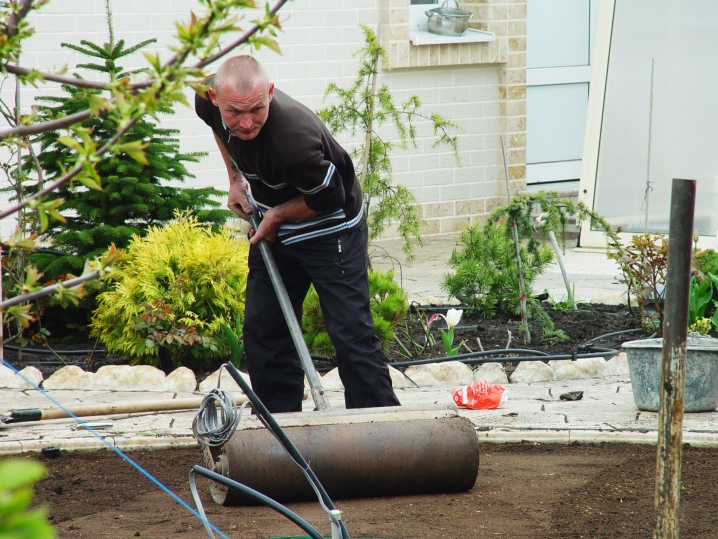
If the alignment of the territory is carried out independently on its own, then it is important to take into account the following recommendations
Before starting all work related to adjusting the territory, you should decide in advance on its purpose and the creation of separate zones (choose a place for placing a pool, arranging a garden and for building)
At this stage, it is necessary to carefully study the site plan and consult with a specialist in the field of land robots, since it is important to analyze the location of groundwater, soil composition and the possibility of further exploitation of the territory. In addition, the direction of water flow and the slope of the relief should be determined.
Since the whole complex of land works is associated with the movement of land, it is necessary to assess the complexity of the implementation of this measure, taking into account the area of the site, the relief and the desired result
Part of the work (leveling small areas) can be done manually using shovels and rakes. For other manipulations, it may be necessary to use a special technique.
The removed upper fertile layer of the earth can be stored for no more than a month, otherwise all aerobic microorganisms may die, and the soil will become unusable (it cannot be enriched with oxygen).
You need to start leveling the land plot before starting the construction of a house, laying out garden paths and carrying out all communication systems. It is best to do this in the fall, since the winter-spring period can be rich in precipitation, and the soil will sag. In addition, a plot leveled in the fall for a vegetable garden during the winter is well saturated with moisture and fertilizers, which will have a positive effect on the cultivation of crops.
Areas with large areas must be leveled using special equipment that can penetrate to a depth of 30 cm. You need to walk the tractor along and across the territory, this will allow the earth to loosen well. If there is a need to move a large amount of soil, it is best to use a bulldozer.
If you plan to allocate an area for a lawn for flowers, then you need to provide it with a perfectly flat surface. For this, levels are set, a check is made for the presence of curvature. In some places, you can remove the top layer of soil, then fill in all the pits and level the bumps. If the soil is heavy, it is recommended to mix the top layer with peat and sand.
To quickly level areas with a slope, you can use removed topsoil from other areas that are considered unsuitable for planting. First, the slope is covered with sand, then with earth. It is allowed to leave a slight slope, it is needed so that melt and rain water does not stagnate. To simplify the process of leveling sections with a slope, the square method will help, for which you need to drive wooden pegs along the perimeter of the territory and then add soil along the level of their height.
When decorating a landscape design on a site, one should not forget about such a main attribute as steps. They can be arranged in the place where there are slopes on the site. If the territory is located on a hill, then one part of it can be leveled, and the other can be equipped with stairs and railings.Once the site is leveled, fountains, small bodies of water and statues can be placed on it.
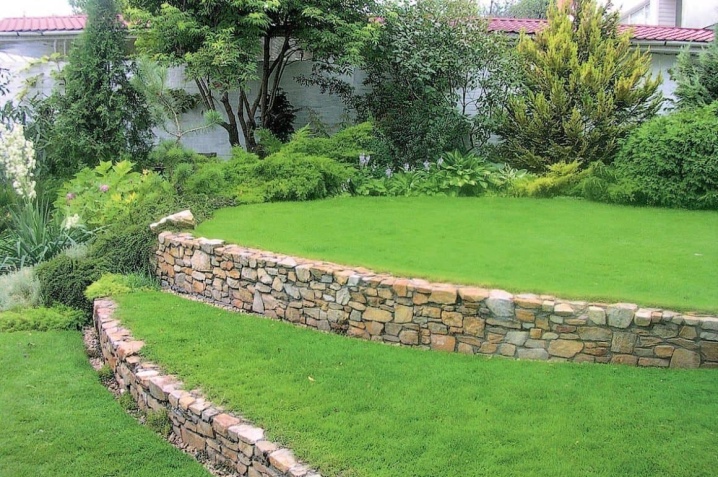
You can see how to properly align the site in the next video.
Tips for a novice gardener: to dig or not to dig?

With the right approach to the ground, it does not deplete, supplying the gardener with crops
The earth is a breathing substance saturated with living organisms. Each "inhabitant" of the soil fulfills his role, working on its structure. With such an understanding, you need to approach your land plot. With such thoughts, you need to take up the shovel. Consider whether you need to dig up the ground. Weigh the pros and cons.
And don't forget about the following points:
- If the soil is loose, rich in humus (sandy loam), then autumn digging is not necessary. It is enough to clean the site, removing foliage and weeds, in which the larvae of pests or disease spores can winter. We'll have to dig up the overgrown area, otherwise in the spring we won't be able to cope
- Spring digging on loose soils is carried out with a flat cutter to a depth of 5 cm.Heavy ones dig shovels onto the bayonet without turning the earthen lump
- Bringing in organic formulas rich in nutrients. On poor soils, you need mineral nutrition, which is added strictly according to the instructions.
- In order not to injure the upper layers once again by loosening, use mulch or sow green manure. All this will keep the surface layer moist and loose. The mulch provides an excellent breeding ground for microorganisms
- If the structure of the soil is disturbed (the earth is dusty, cracked, hard), then together with compost or humus, live preparations with microorganisms in the composition are introduced. They divide quickly and begin to "work", restoring the soil structure

Both natural and synthetic materials can be used as mulch
Over time, nature, without human help, restores the lost fertility. Empty lands are abundantly populated with weeds. Gradually they die, tops, foliage rot, giving food to soil microorganisms. They restore soil structure and fertility.
Proponents of organic farming are cautious about cultivating the soil. By preserving its structure, we multiply the yield, avoid depletion of the fertile layer
Intensive land cultivation technologies do not take into account such moments, so huge areas quickly become unusable. Fertilizers are introduced into them and continue to operate. This approach is based on the fact that feeding a growing humanity is not so easy. But no one canceled the respectful attitude and individual approach.
To dig or not to dig a vegetable garden in the fall? Let's analyze all the pros and cons
Do I need to dig up the ground before planting in the fall or spring: a necessity or a habit? Tips for a novice gardener | (Photo & Video) + Reviews
10
Total Score
Digging the soil for planting
Did our article help you?
10

